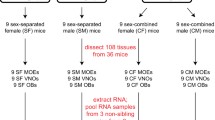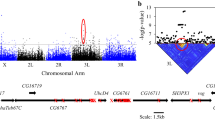Abstract
Olfaction is influenced by a complex mix of environmental and genetic factors that modulate the production, migration, and maturation of cells in the olfactory bulbs. In this study we analyzed effects of sex, age, body weight, and brain weight on olfactory bulb size in sexually mature mice. We then used regression corrected values (residuals) to map quantitative trait loci (QTLs) that selectively modulate bulb weight. This biometric analysis has relied on an F2 intercross between C57BL/6J (B6) and DBA/2J (D2) inbred strains and a large sample of 35 BXD recombinant inbred (RI) strains. Bilateral bulb weight in adult mice ranges from 10 to 30 mg. Half of this remarkable variation can be predicted from differences in brain weight, sex, body weight, and age. A 100-mg difference in brain weight is associated with a 4.4-mg difference in bulb weight. Bulbs gain in weight by 0.2 mg/week—a 1% increase that continues until at least 300 days of age. Males tend to have slightly larger bulbs than females. By combining data from both related crosses (F2 and RI) we identified four QTLs with selective effects on bulb size (genomewide p < .05). Bulb4a is located on chromosome 4 (Chr 4) and Bulb6a is located on Chr 6. Alleles inherited from B6 at both of these loci increase bulb weight by 0.5-1.0 mg. Bulb11a is located on proximal Chr 11 and Bulb17a is located on the proximal part of Chr 17. In contrast to the first two QTLs, B6 alleles at these two loci decrease bulb weight by 0.5-1.0 mg. Collectively, the four loci account for 20% of the phenotypic variance in bulb weight.
Similar content being viewed by others
REFERENCES
Airey, D. C., Lu, L.,Williams, R. W. (2001) Genetic control of the mouse cerebellum: identification of quantitative trait loci modulating size and architecture. J. Neurosci. 21: ( in press).
Allison, A. C. (1953). The morphology of the olfactory system in vertebrates. Biol. Rev. 28: 195-244.
Axel, R. (1995). The molecular logic of smell. Sci. Am. 1273: 154-159.
Baker, H.,Franzen, L.,Stone, D.,Cho, J. Y., andMargolis, F. L. (1995). Expression of tyrosine hydroxylase in the aging, rodent olfactory system. Neurobiol. Aging 16: 119-128.
Benson, T. E.,Ryugo, D. K., andHinds, J. W. (1984). Effects of sensory deprivation on the developing mouse olfactory system: A light and electron microscopic, morphometric analysis. J. Neurosci. 4: 638-653.
Bhatnagar, K. P.,Kennedy, R. C.,Baron, G., andGreenberg, R. (1987). Number of mitral cells and bulb volume in the aging human olfactory bulb: a quantitative morphological study. Anat. Rec. 218: 73-87.
Brunjes, P. C. (1994). Unilateral naris closure and olfactory system development. Brain Res. Rev. 19: 146-160.
Buck, L. B. (1996). Information coding in the vertebrate olfactory system. Annu. Rev. Neurosci. 19: 517-544.
Buck, L., andAxel, R. (1991). A novel multigene family may encode odorant recognition. Cell 65: 175-187.
Cheng, C. M.,Joncas, G.,Reinhardt, R. R.,Farrer, R.,Quarles, R.,Janssen, J.,McDonald, M. P.,Crawley, J. N.,Powell-Braxton, L., andBondy, C. A. (1998). Biochemical and morphometric analyses show that myelination in the insulin-like growth factor 1 null brain is proportionate to its neuronal composition. J. Neurosci. 18: 5673-5681.
Churchill, G. A., andDoerge, R. W. (1994). Empirical threshold values for quantitative trait mapping. Genetics 138: 963-971.
Coopersmith, R., andLeon, M. (1984). Enhanced neural response to familiar olfactory cues. Science 225: 849-851.
Cremer, H.,Lange, R.,Christoph, A., et al. (1994). Inactivation of the N-CAM gene in mice results in size reduction of the olfactory bulb and deficits in spatial learning. Nature 367: 455-459.
Darvasi, A. (1998). Experimental strategies for the genetic dissection of complex traits in animals. Nature Genet. 18: 19-24.
Dellovade, T. L.,Pfaff, D. W., andSchwanzel-Fukuda, M. (1998). Olfactory bulb development is altered in small-eye (Sey) mice. J. Comp. Neurol. 402: 402-418.
Dietrich, W. F.,Miller, J. C.,Steen, R. G., et al. (1994). A genetic map of the mouse with 4,006 simple sequence length polymorphisms. Nature Genet. 7: 220-245.
Falconer, D. S., andMackay, T. F. C. (1996). Introduction of Quantitative Genetics, 4th ed., Addison-Wesley, New York.
Finlay, B. L., andDarlington, R. B. (1995). Linked regularities in the development and evolution of the mammalian brain. Science 268: 1578-1584.
Gheusi, G.,Cremer, H.,McLean, H.,Chazal, G.,Vincent, J. D., andLledo, P. M. (2000). Importance of newly generated neurons in the adult olfactory bulb for odor discrimination. Proc. Natl. Acad. Sci. USA 97: 1823-1828.
Gittleman, J. L. (1991). Carnivore olfactory bulb size: allometry, phylogeny and ecology. J. Zool. Lond. 225: 253-272.
Haley, C. S., andKnott, S. A. (1992). A simple regression method for mapping quantitative trait loci in line crosses using flanking markers. Heredity 69: 315-324.
Kulkarni, A.,Airey, D. C., andWilliams, R. W. (2000). Genetic architecture of the mouse retinogeniculate system: A QTL analysis of numerical matching. Soc. Neurosci. Abstr. 26: 1087.
Laird, P. W.,Zijderveld, A.,Linders, K.,Rudnicki, M.,Jaenisch, R., andBerns, A. (1991). Simplified mammalian DNA isolation procedure. Nucleic Acids Res. 19: 4293.
LaMantia A. S.,Pomeroy S. L., andPurves D. (1992). Vital imaging of glomeruli in the mouse olfactory bulb. J. Neurosci. 12: 976-988.
Lois, C., andAlvarez-Buylla, A. (1994). Long-distance neuronal migration in the adult mammalian brain. Science 264: 1145-1148.
Love, J. M.,Knight, A. M.,McAleer, M. A., andTodd, J. A. (1990). Towards construction of a high resolution map of the mouse genome using PCR-analyzed microsatellites. Nucleic Acids Res. 18: 4123-4130.
Lu, L.,Airey, D. C., andWilliams, R. W. (2001). Genetic architecture of the mouse hippocampus: Identification of loci with specific effects on hippocampal size. J. Neurosci. 21: 3503-3514.
Maruniak, J. A.,Taylor, J. A.,Henegar, J. R., andWilliams, M. B. (1989). Unilateral naris closure in adult mice: Atrophy of the deprived-side olfactory bulbs. Brain Res. Dev. 47: 27-33.
Pomeroy, S. L.,LaMantia, A. S., andPurves, D. (1990). Postnatal construction of neural circuitry in the mouse olfactory bulb. J. Neurosci. 10: 1952-1966.
Ressler, K. J., Sullivan, S., and Buck, L. B. (1994). Information coding in the olfactory system: Evidence for a stereotyped and highly organized epitope map in the olfactory bulb. Cell 79: 1245-1255.
Rikke, B. A., andJohnson, T. E. (1998). Towards the cloning of genes underlying murine QTLs. Mammal. Genome 9: 963-968.
Rosen, G. D., andWilliams, R. W. (2001). Complex trait analysis of the mouse striatum: independent QTLs modulate volume and neuron number. BMC Neurosci. 2: 5. (www.biomedcentral.com/ 1471-2022/2/5).
Rosselli-Austin, L., andWilliams, J. (1990). Enriched neonatal odor exposure leads to increased numbers of olfactory bulb mitral and granule cells. Dev. Brain Res. 51: 135-137.
Royet, J.,Jourdan, F.,Ploye, H., andSouchier, C. (1989). Morphometric modifications associated with early sensory experience in the rat olfactory bulb. II. Stereological study of the population of olfactory glomeruli. J. Comp. Neurol. 289: 594-609.
Royet, J.,Souchier, C.,Jourdan, F., andPloye, H. (1988). Morphometric study of the glomerular population in the mouse olfactory bulb: Numerical density and size distribution along the rostrocaudal axis. J. Comp. Neurol. 270: 559-568.
Royet, J.,Distel, H.,Hudson, R., andGervais, R. (1998). A reestimation of the number of glomeruli and mitral cells in the olfactory bulb of rabbit. Brain Res. 788: 35-42.
Sandberg, R.,Yasuda, R.,Pankratz, D. G.,Carter, T. A.,Del Rio, J. O.,Wodicka, L.,Mayford, M.,Lockhart, D. J., andBarlow, C. (2000). Regional and strain-specific gene expression mapping in the adult mouse brain. Proc. Natl. Acad. Sci. USA 97: 11039-11043.
Shepherd, G. M., andGreer, C. A. (1998). Olfactory bulb. In Shepherd, G. M. (ed.), The Synaptic Organization of the Brain, 4th ed., Oxford, University Press, New York.
Sokal, R. R., andRohlf, F. J. (1995). Biometry: The Principles and Practice of Statistics in Biological Research, 3rd ed., W. H. Freeman, New York.
Strom, R. C. (1999). Genetic Analysis of Variation in Neuron Number, Dissertation, University of Tennessee, Memphis. (www. nervenet.org/papers/Strom99/Thesis.html)
Strom, R. C., andWilliams, R. W. (1998). Cell production and cell death in the generation of variation in neuron number. J. Neurosci. 18: 9948-9953.
Tomasiewicz, H.,Ono, K.,Yee, D.,Thompson, C.,Gioridis, C.,Rutishauser, U., andMagnuson, T. (1993). Genetic deletion of a neural cell adhesion molecule variant (N-CAM-180) produces distinct defects in the central nervous system. Neuron 11: 1163-1174.
Taylor, B. A. (1989). Recombinant inbred strains. In Lyon, M. L., andSearle, A. G. (eds.), Genetic Variants and Strains of the Laboratory Mouse, 2nd ed., Oxford, University Press, Oxford, pp. 773-796.
Taylor, B. A.,Wnek, C.,Kotlus, B. S.,Roemer, N.,MacTaggart, T., andPhillips, S. J. (1999). Genotyping new BXD recombinant inbred mouse strains and comparison of BXD and consensus maps. Mammal. Genome 10: 335-348.
Tropepe, V.,Craig, C. G.,Morshead, D. M., andvan der Kooy, D. (1997). Transforming growth factor-a null and senescent mice show decreased neural progenitor cell proliferation in the forebrain subependmya. J. Neurosci. 17: 7850-7859.
van der Kooy, D., andWeiss, S. (2000). Why stem cells. Science 287: 1439-1442.
Vassar, R.,Chou, S. K.,Sitcheran, R.,Nunez, J. M.,Vosshall, G. L., andAxel, R. (1994). Topographic organization of sensory projections to the olfactory bulb. Cell 74: 309-318.
Williams, R. W. (1998). Neuroscience meets quantitative genetics: Using morphometric data to map genes that modulate CNS architecture. In Morrison, J., andHof, P. (eds.), Short Course in Quantitative Neuroanatomy, Society for Neuroscience, Washington, DC, pp. 66-78. (www.nervenet.org/papers/Short-Course98.html)
Williams, R. W. (2000). Mapping genes that modulate mouse brain development: A quantitative genetic approach. In Goffinet, A., andRakic, P. (eds.), Mouse Brain Development, Springer, Berlin, pp.21-49.
Williams, R. W.,Strom, R. C.,Rice, D. S., andGoldowitz, D. (1996). Genetic and environmental control of retinal ganglion cell number in mice. J. Neurosci. 16: 7193-7205.
Williams, R. W.,Strom, R. C., andGoldowitz, D. (1998). Natural variation in neuron number in mice is linked to a major quantitative trait locus on Chr 11. J. Neurosci. 18: 138-146.
Woo, C. C.,Coopersmith, R., andLeon, M. (1987). Localized changes in olfactory bulb morphology associated with early olfactory learning. J. Comp. Neurol. 263: 113-125.
Yang, X. W.,Wynder, C.,Doughty, M. L., andHeintz, N. (1999). BAC-mediated gene-dosage analysis reveals a role for Zipro1 (Ru49/Zfp38) in progenitor cell proliferation in cerebellum and skin. Nature Genet. 22: 327-335.
Zhou, G., andWilliams, R. W. (1999). Eye1 and Eye2:Gene loci that modulate eye size, lens weight, and retinal area in mouse. Invest. Ophthalmol. Vis. Sci. 40: 817-825.
Author information
Authors and Affiliations
Rights and permissions
About this article
Cite this article
Williams, R.W., Airey, D.C., Kulkarni, A. et al. Genetic Dissection of the Olfactory Bulbs of Mice: QTLs on Four Chromosomes Modulate Bulb Size. Behav Genet 31, 61–77 (2001). https://doi.org/10.1023/A:1010209925783
Issue Date:
DOI: https://doi.org/10.1023/A:1010209925783




